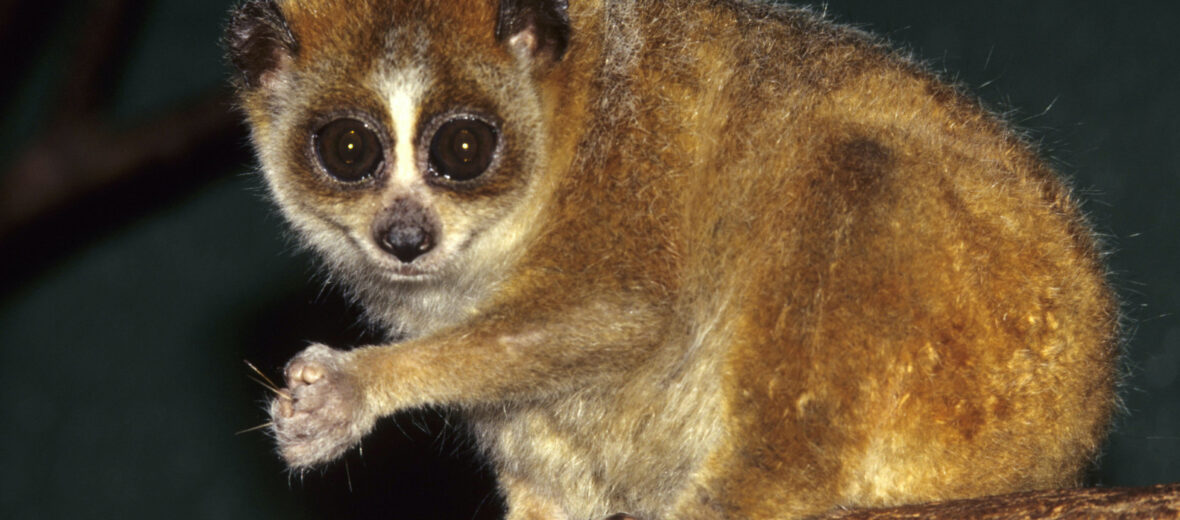
The pygmy slow loris is an adorable critter that can be found near the Mekong River, in eastern Cambodia, Laos, and the Yunnan province in the south of China. They prefer primary and secondary rainforests, evergreen forests, degraded habitats, and bamboo thickets. Due to habitat destruction, hunting, and trapping these beautiful creatures are listed as Endangered by the IUCN. Sadly too, their populations are decreasing.
First the Stats…
Scientific name: Nycticebus pygmaeus
Weight: Up to 15 ounces
Length: Up to 9.1 inches
Lifespan: Up to 20 years
Now on to the Facts!
1.) Slow lorises are nocturnal (active at night).
2.) Lorises are arboreal (spend their lives in trees).
3.) During the summer months, they move about almost constantly. In winter, when the temperatures drop, they enter into torpor (a hibernation-like resting period).
4.) They are predominantly solitary. But have also been described as gregarious (sociable).
5.) The pygmy slow loris eats insects (especially those with a pungent odor), many types of fruits and plants. They prefer various gums and soft fruits, though they will happily consume tender shoots and other parts of plants.
But wait, there’s more on the pygmy slow loris!
6.) Communication is based on vocalizations, in the form of whistles and they also rely on scenting.
7.) Females undergo up to a 6 month gestation (pregnancy) that yields up to 2 infants.
Did you know…?
The slow lorises are the only known poisonous and venomous primates in the world. Their elbows ooze a noxious oil that, when mixed with saliva, turns into a potent venom which is strong enough to rot flesh. For defense, they will lick their elbows and administer the toxin to their teeth. Then they can deliver their venomous bite which causes tissue necrosis (tissue death).
8.) Infants are born mostly precocial (fully developed, with eyes open).
9.) The babies are nursed for up to 4.5 months before starting life out on their own.
10.) These critters traverse the trees via a hand over foot method. Each movement is slow and calculated.
But wait, there’s still more on the pygmy slow loris!
11.) Males tend to settle disputes via the use of venomous bites. Many studied lorises were shown to be disfigured, due to the flesh rotting bite of another loris.
12.) Their bite not only causes tissue necrosis, but also causes severe pain.
Did you know…?
Dutch explorers in the 18th century brought back some loris specimens, and dubbed them “loeris” which means “clown”. It is still uncertain if that name was based on the loris’s coloration or their behavior.
13.) Mothers will also apply the venom as a poison to her infants, by licking them with the oils from her toxin glands, she smears the toxin all over her baby, thus giving a would-be predator a heck of a surprise if they try to eat her babies.
14.) Snakes, changeable hawk-eagles, orangutans, cats, viverrids (civet family), and sun bears are all known to prey on these lorises. But humans are their biggest threat.
15.) Other venomous mammals besides these slow lorises include critters like vampire bats, the duck-billed platypus, some shrews, certain moles, and solenodons.
But wait, there’s still a little more on the pygmy slow loris!
16.) While sleeping, these lorises will curl up in a tight ball with their head between their legs.
17.) While feeding, these cute critters will often hang upside-down, by their feet, in order to reach food. This position frees up their hands in order to manipulate the food into their mouth.
18.) Sadly, these and other lorises are captured and sold in markets, in Asia, as pets. They do not make good pets and often suffer at the hands of poor husbandry, only to die a painful death. Also, contrary to what some videos have shown, they do not like to be tickled! This is excruciating for them!
Now a Short Pygmy Slow Loris Video!
Be sure to share & comment below! Also, check out the Critter Science YouTube channel. Videos added frequently!
Want to suggest a critter for me to write about? Let me know here.



